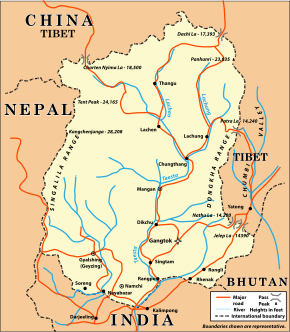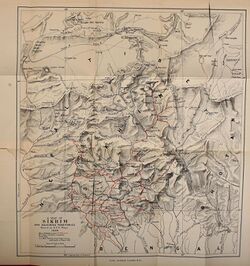History:Kingdom of Sikkim
Kingdom of Sikkim འབྲས་ལྗོངས། (Sikkimese) Drenjong འབྲས་མོ་གཤོངས། (Classical Tibetan) Dremoshong ᰕᰚᰬᰯ ᰜᰤᰴ (Lepcha) Mayel Lyang | |||||||
|---|---|---|---|---|---|---|---|
| 1642–1975 | |||||||
Motto: "Oh, the jewel of creation is in the Lotus"[1] | |||||||
Anthem: Drenjong Silé Yang Chhagpa Chilo[2] "Why is Sikkim Blooming So Fresh and Beautiful?" | |||||||
 Kingdom of Sikkim | |||||||
| Status |
| ||||||
| Capital |
| ||||||
| Official languages | Chöke, Sikkimese | ||||||
| Common languages | Lepcha (early period), Dzongkha, Nepali (late period) | ||||||
| Religion | Tibetan Buddhism | ||||||
| Demonym(s) | Drenjop, Sikkimese | ||||||
| Government | Absolute monarchy (until 1973) Parliamentary constitutional monarchy (1973–1975) | ||||||
| Chogyal | |||||||
• 1642–1670 (first) | Phuntsog Namgyal | ||||||
• 1963–1975 (last) | Palden Thondup Namgyal | ||||||
| Legislature | State Council of Sikkim | ||||||
| History | |||||||
• Established | 1642 | ||||||
• Treaty of Titalia signed | 1817 | ||||||
• Darjeeling given to British India | 1835 | ||||||
• Palden Thondup Namgyal forced to abdicate | 1975 | ||||||
• Merger with India | 16 May 1975 | ||||||
| Currency | Rupee | ||||||
| |||||||
| Today part of | India | ||||||
The Kingdom of Sikkim (Classical Tibetan and Template:Lang-sip, Drenjong), officially Dremoshong (Classical Tibetan and Template:Lang-sip) until the 1800s, was a hereditary monarchy in the Eastern Himalayas which existed from 1642 to 16 May 1975, then it was merged[4][5][6] with the India . It was ruled by Chogyals of the Namgyal dynasty.[7]
History
Nepalese-Bhutanese domination
In the mid-18th century, Sikkim was invaded by both Nepal (then the Gorkha Kingdom) and Bhutan (then ruled by Gedun Chomphel) and was under both the Gorkha and the Bhutanese rule for more than 40 years. Between 1775 and 1815, almost 180,000 ethnic Nepalis[8] from Eastern and Central Nepal migrated to Sikkim.[citation needed] After the British colonisation of India, however, Sikkim allied itself with British India in order to fight Nepal, their common enemy at the time.[citation needed] The Nepalese then attacked Sikkim, overrunning most of the region including the Terai. This prompted the British East India Company to attack Nepal in 1814, resulting in the Anglo-Nepalese War.[citation needed] The Sugauli Treaty between Britain and Nepal and the Treaty of Titalia between Sikkim and British India resulted in territorial concessions by Nepal, which ceded Sikkim to British India.[9]
British and Indian protectorate
Under the 1861 Treaty of Tumlong, Sikkim became a British protectorate, then an Indian protectorate in 1950.[10]
Thutob Namgyal, the 9th Chogyal of Sikkim, looked to the Dalai Lama for spiritual leadership and during his reign the Tibetan government started to regain political influence over Sikkim. In 1888 the British sent a military expedition to expel Tibetan forces from Sikkim.
Accession to India
In 1975, allegations of discrimination against Nepali Hindus in Sikkim led to resentment against the Chogyal.[11][12] Their instigation led to Indian Army personnel moving into Gangtok. According to Sunanda K. Datta-Ray of The Statesman, the army killed the palace guards and surrounded the palace in April 1975.[10]
After disarming the palace, a referendum on the monarchy was held, in which the Sikkimese people overwhelmingly voted to abolish the monarchy, and the new parliament of Sikkim, led by Kazi Lhendup Dorjee, proposed a bill for Sikkim to become an Indian state, which was promptly accepted by the Government of India.[10][13]
Culture and religion
In culture and religion, Sikkim was linked closely with Tibet, from which its first king migrated, and Bhutan, with which it shares borders. The presence of a large ethnic Nepali population, mainly from eastern and central Nepal, also leads to cultural linkages with Nepal.
See also
- Sikkim
- History of Sikkim
- Chogyal
- List of heads of government of the Kingdom of Sikkim
- List of political officers in the Kingdom of Sikkim
References
Citations
- ↑ "Sikkim / Dämojong". http://www.hubert-herald.nl/BhaSikkim.htm.
- ↑ Hiltz, Constructing Sikkimese National Identity 2003, p. 80–81.
- ↑ According to Article II of Convention of Calcutta, Sikkim was a direct protectorate of the British Government, not the British Indian government.
- ↑ "16th May 1975: The Kingdom of Sikkim and its Annexation with India". 16 May 2018. https://eurasiantimes.com/sikkim-history-india-annexed/.
- ↑ "Did India have a right to annex Sikkim in 1975?" (in en). https://www.indiatoday.in/magazine/cover-story/story/19780430-did-india-have-a-right-to-annex-sikkim-in-1975-818651-2015-02-18.
- ↑ Abrahams, Pema (2023-06-01). "The Forgotten Kingdom" (in en-US). https://foreignpolicy.com/2015/05/20/the-forgotten-kingdom-sikkim-forty-years-india/.
- ↑ Marathe, Om (2019-08-20). "Explained: Sikkim, from Chogyal rule to Indian state" (in en). https://indianexpress.com/article/explained/explained-sikkim-chogyal-rule-to-indian-state-sdf-bjp-5921574/.
- ↑ Chettri, Mona (2013). "Ethnic politics in the Nepali public sphere three casesfrom the eastern Himalaya.". https://eprints.soas.ac.uk/18060/1/Chettri_3563.pdf.
- ↑ "History of Nepal: A Sovereign Kingdom". Official website of Nepal Army. http://www.nepalarmy.mil.np/history.php?page=two.
- ↑ 10.0 10.1 10.2 "Indian hegemonism drags Himalayan kingdom into oblivion". Nikkei. Nikkei Asian Review. 21 February 2016. http://asia.nikkei.com/Politics-Economy/International-Relations/Indian-hegemonism-drags-Himalayan-kingdom-into-oblivion?page=1.
- ↑ Larmer, Brook (March 2008). "Bhutan's Enlightened Experiment". National Geographic (Bhutan). (print version). http://ngm.nationalgeographic.com/2008/03/bhutan/larmer-text/8.
- ↑ "25 years after Sikkim". Nepali Times (#35). 23–29 March 2001. http://nepalitimes.com/news.php?id=9621#.V89C9zVGRhY.
- ↑ Sethi, Sunil (18 February 2015). "Treaties: Annexation of Sikkim". India Today. India Today. http://indiatoday.intoday.in/story/did-india-have-a-right-to-annex-sikkim-in-1975/1/435037.html.
Sources
- Hiltz, Jackie (2003), "Constructing Sikkimese National Identity in the 1960s and 1970s", Bulletin of Tibetology, https://www.repository.cam.ac.uk/bitstream/handle/1810/243140/bot_2003_02_04.pdf?sequence=1, retrieved 1 August 2017
Further reading
- Duff, Andrew (2015). Sikkim: Requiem for a Himalayan Kingdom. Edinburgh: Birlinn. ISBN 978-0-85790-245-0.
- Rai, Rajiv (2015), The State in the Colonial Periphery: A Study on Sikkims Relation with Great Britain, Partridge Publishing India, ISBN 978-1-4828-4871-7, https://books.google.com/books?id=mstdCgAAQBAJ
- Rose, Leo E. (Spring 1969), "India and Sikkim: Redefining the Relationship", Pacific Affairs 42 (1): 32–46, doi:10.2307/2754861
- Rose, Leo E. (1971), Nepal – Strategy for Survival, University of California Press, ISBN 978-0-520-01643-9, https://books.google.com/books?id=v07Vo3vAaKwC
- Sharma, Suresh Kant; Sharma, Usha (2005), Discovery of North-East India: Geography, History, Culture, Religion, Politics, Sociology, Science, Education and Economy. Sikkim. Volume ten, Mittal Publications, pp. 117–, ISBN 978-81-8324-044-4, https://books.google.com/books?id=kBk3xBjSRbsC&pg=PA117
- Singh, Amar Kaur Jasbir (1988), Himalayan triangle: a historical survey of British India's relations with Tibet, Sikkim, and Bhutan, 1765–1950, British Library, ISBN 9780712306300, https://books.google.com/books?id=4dq1AAAAIAAJ
External links
- "Buddhist Monasteries of Sikkim". Sikkim.nic.in.
- Kingdom of Sikkim at Curlie
- Climbing the clouds to Sikkim
- Kings of Sikkim
- The Sikkim saga, through an American lens
 |




